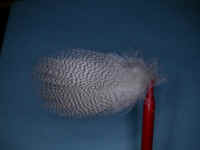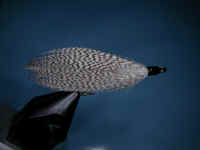|
Fly of
the Month
Bob Ireton brings together his
experience in fly fishing, aquatic entomology, and knowledge of fly
tying techniques and materials, to design and tie durable and
effective flies.
|

|

Volume 4, Issue 10 October
2003

MALLARD MINNOW
Fly, Text, and Photography by Bob Ireton
In the March 1985 issue of Fly Fishing
Magazine, the Mallard Minnow was referred to as an 'old fashioned
soft-hackle streamer'. I really couldn't find much information about this
fly in all my reference material. Nothing in the pattern books, and I
don't think it is carried in the fly shops anymore. I remember some of the
veteran fly fisherman spoke highly of this fly, though. It looks like a
nice minnow imitation to me.
The most difficult aspect of this fly is
finding nice Mallard flank feathers. Luckily, I had a supply that I
harvested from a fresh skin someone obtained while hunting. The actual
tying process is rather simple. Fish this pattern just like any other
streamer that is a minnow imitation.
MATERIALS
.
Hook - Daiichi 1750, Mustad 9674, Orvis 0167, TMC 9395, or most any
4X streamer hook.
Size - 12 to 1/0.
Thread - 6/0 Black.
Weight - .025 lead wire.
Body - 2 pairs Mallard flank feathers.
TYING STEPS - click
on pictures for larger view
| 1 - Place the hook properly
in the vice, and bend down or rollover the barb, if desired. Attach
the thread behind the eye of the hook, and lay on a base of close
wrapped thread rearward, stopping above the barb. Tie a half hitch.. |
 |
|
2 - You will need to weight this fly
because the Mallard flank feathers are buoyant. Apply the lead wire to
the mid section of the hook shank, leaving room on each end of the
lead to form a thread ramp. You want the weight to cause the finished
fly to ride in a horizontal plane, like a minnow. |
 |
| 3 - Build a ramp of thread
on each end of the lead, and cover the lead wraps with thread in the
process. Bring the thread forward, and tie a half hitch. Apply head
cement to cover all the thread. |
 |
| 4 - The pair of Mallard
flank feathers should be of equal size, coloration, and barring. When
observing a pair of feathers from above, the cupped surface should be
facing inward, as the tips fall inward and downward. You need two
matching pairs for the fly. |
 |
| 5 - The two matching flank
feathers for the side of the fly facing the tyer will fit closely
together, and look like the picture example. |
 |
| 6 - We will do the pair on
the back side first. Line the two feathers for the back side together.
We want the feathers to become more compact and tightly fitting within
each other. Do this by wetting your fingers with clean water, and
stroke the feathers from the shaft to the tips. They will look as
pictured. Note: do not use your mouth to dampen the feathers, because
you don't know what might be on them! |
 |
| 7 - Place the feathers
against the back side of the hook. You want the tips to extend
approximately 3/8 inch past the hook bend. If they extend much beyond
this, the fish will 'short strike' the fly. Initially, let the feather
tips extend slightly beyond this amount. Secure the feathers using a
couple of soft loops, then carefully pull the feathers forward till
3/8 inch extends past the hook bend. Secure with several more firm
wraps of thread, and leave working thread hanging in place. |
 |
| 8 - Snip off the butts of
the feathers, and tie a half hitch. Take the pair of feathers for the
front side of the fly, and prepare them as you did the pair used on
the back side by moistening your fingers with water, and stroking the
feathers together and rearward. |
 |
| 9 - Lay the pair of flank
feathers against the front of the fly, and attach in the same way you
did the back side. Snip off the feather butts, and form a thread head.
Tie a half hitch on the head next to the feathers, then tie a whip
finish knot going forward to give a strong and attractive result. Snip
off the working thread, and put head cement on the head. |
 |

The Buckeye United Fly
Fishers, Inc is a non-profit corporation organized under section 501(c)(3)
of the Internal Revenue Code, incorporated in the State of Ohio for the
preservation, conservation and wise use of our fishing waters and game
fish; and to assist in the protection and improvement of our natural
resources
|

![]()
![]()
![]()








